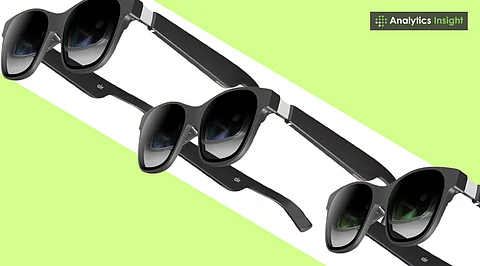Smart glasses have evolved significantly by 2025, seamlessly integrating augmented reality (AR), artificial intelligence (AI), and advanced audio features into stylish designs. With a variety of options available, from premium to budget models, these devices cater to diverse lifestyles and needs. This year, smart glasses are not just futuristic gadgets; they have become essential tools for entertainment, productivity, and communication.
Leading Innovations in Smart Glasses
Manufacturers are pushing the boundaries of technology. The latest models boast cinematic visuals, real-time translations, and voice-activated AI assistance. Major players like Xreal, Ray-Ban, and Meta have set high standards, while companies like Viture, Solos, and Nuance are also making significant contributions to this rapidly evolving market.
The Xreal One Pro, priced around $649 (approximately Rs. 53,000 – Rs. 55,000 INR), stands out with its impressive 1080p display and expansive 171-inch virtual screen. It features a 120Hz refresh rate for smooth visuals and a spatial computing chip for reliable performance. This model transforms any environment into a digital workspace, making it ideal for gaming, media consumption, and multitasking.
Ray-Ban Meta Smart Glasses merge iconic style with advanced technology, retailing between $500 and $600 (Rs. 42,000 – Rs. 50,000 INR). Equipped with voice-controlled Meta AI, these glasses allow users to access live translations and capture moments with a built-in camera. The open-ear audio system maintains situational awareness while delivering high-quality sound, blending fashion and function effectively.
Affordable and Accessible Options
For those seeking budget-friendly alternatives, the RayNeo Air 3S offers a solid entry point with prices ranging from $399 to $499 (Rs. 32,000 – Rs. 42,000 INR). These smart glasses provide sharp visuals and reliable audio, making them suitable for casual users and students. Their lightweight design ensures comfort for daily wear, making AR technology more accessible.
The Viture Luma Pro, priced at approximately $800 (Rs. 65,000+ INR), enhances media consumption with its micro-OLED screens and large field of view, ideal for streaming and gaming on the go. Meanwhile, the Rokid AR Lite and Max 2, estimated between $700 and $900 (Rs. 57,000 – Rs. 75,000 INR), offer portable cinematic experiences, merging everyday activities with augmented reality.
Additionally, the Solos AirGo 3 smart glasses, priced around $600 (Rs. 50,000 INR), utilize built-in AI for voice assistance, making them a practical choice for professionals and travelers. The Halliday AI glasses, ranging from $400 to $500 (Rs. 33,000 – Rs. 42,000 INR), adopt a minimalist approach, displaying essential information while keeping the real world in view.
Trendy Designs and Versatile Uses
The trend for smart glasses in 2025 emphasizes the combination of advanced features with modern aesthetics. Chamelo Music Shield and Echo Frames are designed for audio enthusiasts, with prices ranging from $200 to $400 (Rs. 16,000 – Rs. 33,000 INR). While Chamelo focuses on delivering rich sound through open-ear audio, Echo Frames integrate smart home capabilities, allowing users to control their environment with voice commands.
Ultimately, the selection of smart glasses in 2025 reflects a shift toward functionality, comfort, and style. Each model offers unique features tailored to specific needs, whether for entertainment, productivity, or accessibility. As these devices continue to develop, they have become essential companions in daily life.
For those interested in purchasing smart glasses, options are readily available through brand websites and major retailers like Amazon and Best Buy. With a variety of choices on the market, potential buyers are encouraged to compare features and read reviews to find the most suitable model for their needs.
In summary, smart glasses have transcended their initial novelty to become integral to modern life. With various models available, from high-end options like the Xreal One Pro to budget-friendly choices like the RayNeo Air 3S, the future of wearable technology is bright, and its potential is being realized through these innovative devices.






































































